溫馨提示×
您好,登錄后才能下訂單哦!
點擊 登錄注冊 即表示同意《億速云用戶服務條款》
您好,登錄后才能下訂單哦!
這篇文章給大家分享的是有關怎么使用Python實現感知器算法的內容。小編覺得挺實用的,因此分享給大家做個參考,一起跟隨小編過來看看吧。
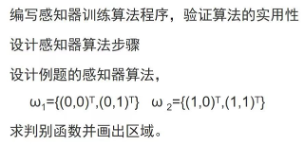
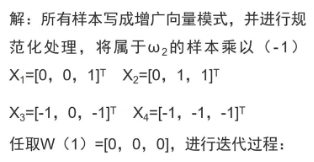
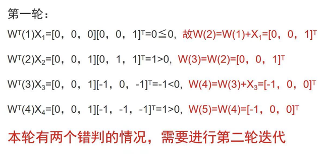
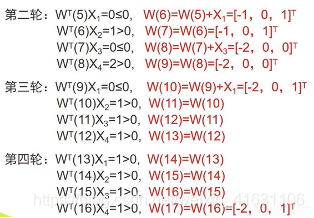
該輪迭代分類結果全部正確,判別函數為g(x)=-2x1+1
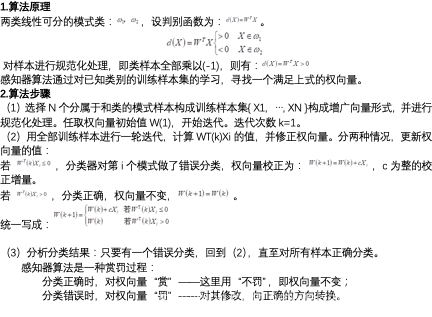
(1)由數學求解過程可知:

(2)程序運行結果

(3)繪圖結果
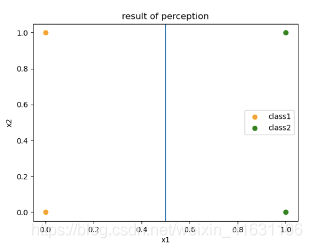
'''
20210610 Julyer 感知器
'''
import numpy as np
import matplotlib.pyplot as plt
def get_zgxl(xn, a):
'''
獲取增廣向量
:param x: 數組
:param a: 1或-1
:return:
'''
temp = []
if a == 1:
xn.append(1)
if a == -1:
for i in range(len(xn)):
temp.append(xn[i]*(-1))
temp.append(-1)
xn = temp
# print('xn:'+ str(np.array(x).reshape(-1, 1)))
return np.array(xn).reshape(-1, 1)
def calculate_w(w, xn):
'''
已知xn和初始值,計算w
:param w: 列向量 --> wT:行向量
:param xn: 列向量
:return:
'''
# wT = w.reshape(1, -1) # 列向量轉變為行向量,改變w
wT = w.T # 列向量轉變為行向量,不改變w
wTx = np.dot(wT, xn).reshape(-1) # 行向量乘以列向量, 維度降為1。
#wTx = wT@xn # 行向量乘以列向量
if wTx > 0:
w_value = w
else:
w_value = np.add(w, xn)
# print("w_update的shape" + str(w_update.shape))
#print("wTx:" + str(wTx))
return w_value, wTx # w_value為列向量, wTx為一個數
def fit_one(w1, x1, x2, x3, x4):
'''
完成一輪迭代,遍歷一次數據,更新到w5。
:param w1: 初始值
:param x1:
:param x2:
:param x3:
:param x4:
:return: 返回w5和wTx的列表。
'''
wTx_list = []
update_w = w1
for i in range(0, len(x_data)): #len計算樣本個數,通過循環更新w
update_w, wTx = calculate_w(update_w, x_data[i])
wTx_list.append(wTx)
#print(wTx_list)
return update_w, wTx_list
def draw_plot(class1, class2, update_w):
plt.figure()
x_coordinate = []
y_coordinate = []
for i in range(len(class1)):
x_coordinate.append(class1[i][0])
y_coordinate.append(class1[i][1])
plt.scatter(x_coordinate, y_coordinate, color='orange', label='class1')
x_coordinate = []
y_coordinate = []
for i in range(len(class2)):
x_coordinate.append(class2[i][0])
y_coordinate.append(class2[i][1])
plt.scatter(x_coordinate, y_coordinate, color='green', label='class2')
w_reshape = update_w.reshape(-1)
#print
x = np.linspace(0, 2, 5)
if w_reshape[1] == 0:
plt.axvline(x = (-1) * w_reshape[2]/w_reshape[0])
else:
plt.plot(x, (x*w_reshape[0]*(-1) + w_reshape[2]*(-1))/w_reshape[1])
plt.title('result of perception')
plt.xlabel('x1')
plt.ylabel('x2')
plt.legend()
plt.show()
if __name__ == '__main__':
x1 = [0, 0]
x2 = [0, 1]
x3 = [1, 0]
x4 = [1, 1]
class1 = [x1, x2]
class2 = [x3, x4]
x1 = get_zgxl(x1, 1)
x2 = get_zgxl(x2, 1)
x3 = get_zgxl(x3, -1)
x4 = get_zgxl(x4, -1)
x_data = [x1, x2, x3, x4]
# print(x_data)
w1 = np.zeros((3, 1)) # 初始值w1為列向量
#print('w1:' + str(w1) + '\n')
update_w = w1
update_w, wTx_list = fit_one(update_w, x1, x2, x3, x4)
count = 0
iter_number = 0
for wTx in wTx_list:
if wTx > 0:
count += 1
if count < 4:
update_w, wTx_list = fit_one(update_w, x1, x2, x3, x4)
iter_number += 1
else:
break
print('迭代次數為:' + str(iter_number))
print('迭代終止時的w:'+'\n' + str(update_w))
#print(wTx_list)
draw_plot(class1, class2, update_w)感謝各位的閱讀!關于“怎么使用Python實現感知器算法”這篇文章就分享到這里了,希望以上內容可以對大家有一定的幫助,讓大家可以學到更多知識,如果覺得文章不錯,可以把它分享出去讓更多的人看到吧!
免責聲明:本站發布的內容(圖片、視頻和文字)以原創、轉載和分享為主,文章觀點不代表本網站立場,如果涉及侵權請聯系站長郵箱:is@yisu.com進行舉報,并提供相關證據,一經查實,將立刻刪除涉嫌侵權內容。